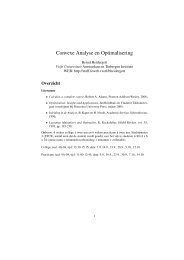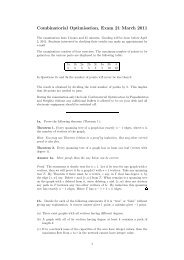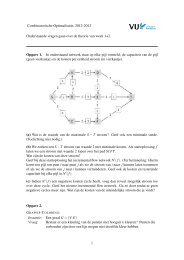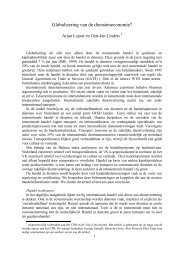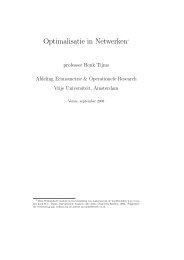Current State of Cross-Border Banking - Vrije Universiteit Amsterdam
Current State of Cross-Border Banking - Vrije Universiteit Amsterdam
Current State of Cross-Border Banking - Vrije Universiteit Amsterdam
Create successful ePaper yourself
Turn your PDF publications into a flip-book with our unique Google optimized e-Paper software.
Graph 3. Geographical segmentation <strong>of</strong> EU and US banks in 2005<br />
Source: Tables 1, 2 and 3.<br />
Individual regions<br />
Turning to the individual regions, table 1 illustrates that the US banks are very domestic (80 to 90%)<br />
with Citibank being the exception. The lifting <strong>of</strong> limits on interstate banking by the Riegle-Neal Act in<br />
1994 has spurred a domestic consolidation drive (Stiroh and Strahan, 2003). <strong>Banking</strong> consolidation<br />
took place among small and medium-sized banks as well as large banks. An example <strong>of</strong> the latter is<br />
Bank <strong>of</strong> America, which is the result <strong>of</strong> a merger between BankAmerica and NationsBank in 1998 and<br />
further mergers with Fleet Boston in 2004 and MBNA in 2006. Bank <strong>of</strong> America has truly national<br />
coverage in the US and is close to holding 10% <strong>of</strong> national deposits. Federal law prevents any bank<br />
from gaining more than 10% <strong>of</strong> national deposits through acquisition. In contrast, Citigroup provides an<br />
example <strong>of</strong> both domestic and cross-border consolidation. Within the US, Citigroup grew out <strong>of</strong> a<br />
merger between Citibank and Travelers (insurance) in 1998. Citigroup has, however, divested most <strong>of</strong><br />
its insurance underwriting business over the last few years. Before the merger, Travelers acquired<br />
Salomon Brothers (investment banking) in 1997. A major foreign acquisition <strong>of</strong> Citigroup is Banamex,<br />
the second largest bank in Mexico (see below), in 2001.<br />
Canadian banks have less domestic business (60 to 70%), while regional business is sizeable (20 to<br />
30%). This can <strong>of</strong> course be explained by the fact that Canada is a smaller country. Finally, Mexico<br />
provides an interesting example <strong>of</strong> a banking system that is dominated by foreign banks. After the<br />
banking crisis <strong>of</strong> 1995, foreign banks were allowed to enter in order to recapitalize Mexican banks<br />
(Ortiz, 2006). Table 6 illustrates that 5 out <strong>of</strong> the 7 largest Mexican banks are owned by foreign banks.<br />
This amounts to about 75% <strong>of</strong> Mexican banking assets. It is noteworthy that not only banks from the<br />
region (Citi and Scotia) but also European banks (BBVA, Santander and HSBC) are active players in<br />
Mexico.<br />
10





